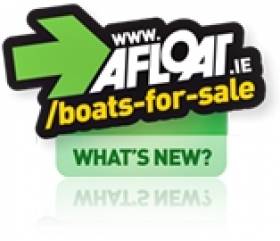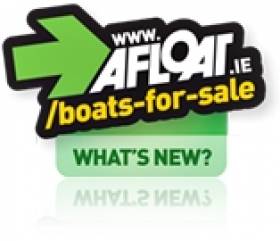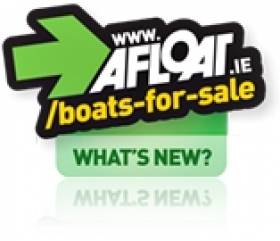Displaying items by tag: for sale
Site of Harland & Wolff Must Not Become Apartments, Says UUP's Lord Empey
#BelfastLough - Harland and Wolff shipyards in Belfast, must be maintained for industrial use and not sold off to property developers, Lord Empey has said.
As The Belfast Telegraph writes, the former UUP leader was speaking after it emerged last week that the historic Belfast company was up for sale as its Norwegian parent company Fred Olsen carries out a major restructuring.
The former shipbuilder behind the Titanic has diversified into renewable energy installations since the last ship sailed out of its famous yard in 2003.
The decline of shipbuilding has also been marked by a steady fall in employee numbers from as many as 30,000 in the 1930s to around 100 today.
Harland and Wolff covers two sites on Queen's Island in east Belfast, including the Belfast Repair Dock where some ship work is still carried out.
There is also the main building dock and manufacturing halls where the famous Samson and Goliath gantry cranes operate.
The combined surface area of the sites is nearly 90 acres.
Former Northern Ireland Enterprise Minister Lord Empey has said that he fears the site may now fall into the hands of property developers.
For further comments by the former politician, click here.
1720 Nationals Beckons With this 1997–Built Boat at €12,500
#1720 – You're in good time for the 1720 National Championships or any of this year's 1720 fixtures (see comment below from the class association) if you opt for this fun one design sports boat that the seller, MGM Boats, says is all set for the 2014 season.
Moored in Cork, this 1997–built boat is a 'really clean' example. The boat comes well equipped with a full sail wardrobe, fully kitted road trailer with masting kit and lockers.
At €12,500, she's yours to sail away!
More on this boat in the one design section of the Afloat Boats for Sale site.
Buying a Boat? Here's a Checklist Before Choosing Your New Craft
#BOATS FOR SALE – It's definitely that time of year again when thoughts turn to getting on the water. If you're buying a boat for the first time, it's probably because you've spent a bit of time on one and like the whole idea. One thing we can guarantee: being on the water is great fun, but it's more than that – it's a way of life. If you take to it, you will begin to see the the world from a different perspective and your leisure time will take on a whole new meaning.
Find a boat that Suits You and Your Pocket
The first and most important consideration is that the boat you buy matches your lifestyle, so you need to know what you want on the water.
So, establish what it is that you most want to do with your boat: the size, how far – or how near – you want to travel, how many people you want to accommodate, what sports events you plan to enter, and whether you'll be inland or offshore.
"A good dealer will ask these questions of a prospective client, and find out exactly what it is they expect from their time on the water," says Tadhg Foley of Marine Action Boats in Tipperary. "Forcing an unsuitable boat onto a client will just backfire on the dealer, as they won't come back for their second – or third – boat, so it's best to be definite about your requirements so the dealer can match boat with buyer. Do you want to ski? Are you going fishing? All these things make a big difference in the type of craft you'll need."
Martin Salmon of MGM Boats says it's important that the buyer gets good value from his boat, in that they get to use it often and well. "We'll often include tuition in a boat-buyer's package," he says, "or make sure that there's an engineer and skipper on board when a new boat owner takes delivery – a 'comprehensive handover', because the more the boat is used, the better."
"If a prospective client has been referred to us by an existing client, we'll often show them a selection of craft and suggest they discuss it with the experienced sailor who referred them to us in the first place," says Hugh Mockler of HM Yachts in Crosshaven. "If they're reluctant to join a sailing school, individual tuition on the new boat can easily be arranged, and joining a club is an excellent way to get into the 'time on the water' way of life. With an active social side and maybe the odd cruise-in-company with like-minded companions, the new boater will soon see the benefits", says Hugh.
Brand New or Pre-Owned
Budget is a big consideration, of course, but there are other factors that will affect whether you buy a new or pre-owned boat.
New boats may suit those who are planning to keep their craft for some time, have been on the water before and know exactly what they want.
However, a five-year-old model could be as much as half the price of a new one, giving you a whole lot more boat for your money. Even a year-old boat will have depreciated by between 20-25% since it left the 'showroom'. There's also the possibility that any snags will be have been ironed out by the previous owner, particularly if they're a careful boater. Martin Salmon of MGM says if you're worred about depreciation, then "buying a used boat can be a good investment if you choose carefully. They don't depreciate as much from the purchase price."
As for the type of boat to buy, the choice is very wide – there are over 40 types out there, and one of them will fit you. Again, it's very much dependant on what you want from your water-based experience. See our 'What's on Offer' guide to boat types and uses.
Brokerage or Private Sale?
As with any big purchase, if you're buying a new boat it's recommended you either buy direct from the manufacturing boatyard or from one of their officially-appointed dealers. Any boat advertised as new that does not appear to originate from either of these sources should be checked out carefully with the boat builder.
There are several routes to buying used boats: from a dealer who has boats in stock as part-exchange; from a broker who sells the boat on behalf of the owner; or from the owners themselves, in a private sale.
Donal McClement of Crosshaven Boatyard in Cork recommends the use of a reputable broker for advice. "The vendor pays the broker's fees, not the buyer, and you have the advantage of the years of experience a broker can bring to the transaction. It's well worth it."
All the necessary paperwork and checks should be in place when buying from dealers and brokers, and their reputation and future business success depends on making their clients happy.
The majority of private sellers are genuine. However, there's a possibility that you're being offered a boat for sale that's stolen, or there's a fraudulent transaction going on. This is the risk taken when not buying from an established business. However, there are precautions you can take to protect yourself and your boating future.
Set the Conditions Before You View
It's a good idea to decide before viewing any boat that you will not buy the first boat you see, or even on the same day you see it. The initial viewing should be part one of a sequence of events to ensure the boat you fancy is really the one for you.
The first view – If it's a new boat, your first visit will be to look over the boat and others in the same range, probably. You'll want to find out about optional extras, colours, delivery lead times, warranty, part exchange (if applicable) and payment terms, as well as price.
A used boat should be checked out for condition; identify any rectification, repairs or improvement work that might need to be done, confirm the asking price and payment terms, and decide if, having examined the boat, you want a sea trial.
The sea trial – If you can take the boat out the first day you see it, so much the better. If not, arrange another time for a sea trial – you have to know how the boat handles on the water.
If it's a power boat, it's good if the engine is cold and not already warmed up when you're taking it out. It could be that it's difficult to start or it may smoke a lot from cold, and with an already-warm engine it's impossible to tell.
Check the boat's steering and handling capabilities at slow speeds, in confined situations. If it's a sea-going boat, see how much it rolls and pitches, taking waves of different sizes at alternative angles; and if it's a planing boat, check how quickly and easily it gets on the plane. Make a mental note of the sea conditions – a boat's performance is relative to the sea condition in which it's operating.
If it's a sailing boat, try different points of sail, sailing into and away from the wind and check the boat's manoeuvrability, stability and performance of the sails and rigging under load. And also check how the boat performs on the engine. At the end of the sea trial, re-examine the bilges, engine compartment and the boat generally for any evidence of oil or water leaks.
Remember also to check used boats for title, charges and theft. "The single most important thing you need, if your boat is a post-1985 model, is proof of payment of VAT," says Donal McClement. "If VAT is paid in one member state, it is considered paid in all member states." Proof of VAT payment can take the form of the original invoice or VAT receipt: "It's unlikely that people would have the VAT receipt, though, as it would come from the original dealer," says Donal. "However, liability rests with the buyer if no proof of payment is provided."
With a used boat there are some checks and information gathering that you should carry out. These checks concern EU RCD compliance, validation of Hull Indentification Number (HIN) number, Declaration of Conformity, the aforementioned evidence of VAT compliance and searches for finance outstanding.
Again, according to Donal at Crosshaven, the CE plate/stamp on the boat is vitally important, so make sure it's there.
When you've seen evidence of build and VAT compliance, and have all of the information that you need to carry out your basic security checks, you should take some time to 'think about it' and get these checks done.
Assuming the boat passes your essential security checks, and that this boat is definitely the one for you, arrange for a professional surveyor to examine the boat. Use a reputable surveyor.
Cutting the Middleman
Bernard Gallagher of Dublin's BJ Marine believes purchasers get the best value from their local dealer: "Most Irish boatyards are dealing direct with the manufacturer, so there's no middle man." Gallagher says the larger manufacturers are offering very good value to their dealers; "We've never bought better, so we can pass on those savings to our customers." He also says it's never been easier to check the value of boats, with access to the internet and boating publications.
So, before entering into negotiations with a seller, you need to decide what price you're prepared to offer and at what price you're prepared to settle.
With a new boat, it's quite rare to pay the brochure price. What you may be offered as a discount depends on many factors such as availability, demand, and model age – it's all down to timing and negotiation.
With used boats, it's less straightforward. The simplest way is to compare the boat you're interested in with other boats for sale of the same make and model. But be sure you're comparing like with like. Age, condition and specification make a difference as well as the ancillary equipment that's included in the sale, so make allowances for any differences in these.
Negotiating A Deal
New boats – Timing is important when buying a new boat. Special deals are often available during boat shows, towards the financial year-end of the boat builder or dealer, and when a model is due to be superseded by an updated version. So do all your research, be aware of model cycles, decide what you want to buy and then try to negotiate at the best time.
If discounts aren't on offer or are lower than you would wish, you might do better to negotiate the inclusion of ancillary equipment in the price; items such as ropes, fenders, lifejackets, GPS, depth sounders, chart plotters and even deck cushions, a CD system or a cooler bag. The value to you is higher than it costs the dealer to supply these items, so having some of them 'thrown in' can be a good compromise.
Used boats – With used boats, the selling price might represent great value as it is, but then again it might not: only your research will tell you which way round it is.
However, any combination of the following should help you to persuade the seller that there is room for negotiation:
• Ancillary equipment that is missing, in poor condition, not working, out of date or not included in the sale;
• Faults and rectification work required and identified by you or your boat surveyor;
• Lack of documentation such as:
– Original sales invoice and evidence of VAT compliance
– Builders certificate and CE declaration of conformity
– Boat manual
– Service history
– Current safety certificate on a canal boat
– VHF radio licence (if applicable). Note: Donal McClement of Crosshaven Boatyard reminded us that the VHF radio licence stays with the craft, "it used to stay with the owner, but now belongs to the boat."
Financing Your Boat
When buying through a dealer or broker, expect to be asked for a deposit, which may be non-refundable if you back out of the transaction. So be sure that you want to buy and have the funds available before you commit.
If you require finance, dealer and brokers may be able to introduce you to alternative sources of borrowing (for which they may receive a commission, so bear this in mind when negotiating).
MGM waiver their commission in lots of cases, according to Salmon. "In the current fiscal climate where finance companies are looking at every detail, it's more important to have the client get finance for the boat they want."
With a marine mortgage, you can normally obtain up to 80% of the purchase price secured against your boat. Before granting a marine mortgage the finance house will require a full, out-of-water survey and valuation on boats other than brand new boats. The lender will also check that there is no finance outstanding on a new boat.
Dealing with a private individual is slightly more complex. They are not professional sellers and will not necessarily know how to formalise the transaction to help protect not only themselves but you as well. So it is as much in your interests as theirs to ensure all potential purchasing disasters are avoided.
What's out there?
Inland Boats
Canal and narrowboats – Usually built of steel, the hulls can last a lifetime if minded. Ideal for pottering peacefully about the canals and less tidal rivers at about 4mph, for days or even weeks at a time. These boats are low maintenance, very economic on fuel and often include most home comforts.
River boats – Usually built of GRP and lighter than their steel counterparts, they're more powerful than narrowboats so can be used comfortably in tidal rivers as well as the odd excursion out to sea in calm conditions. They are, however, more expensive to operate and maintain.
Sea-going boats
Bowriders, cuddy boats, dinghies, dorys and ribs – All different types of day boats that are the ultimate in flexibility whether it's usage, power, speed, manoeuvrability or access to land, coves and beaches. They can be comfortable in calm and slight seas as well as a pleasure to cruise at the appropriate speed up rivers. These boats can usually be trailed and so can be towed to different locations throughout the country, as well as abroad, providing access to a multitude of sea, lake and river locations.
Speedboats, sports boats and sport fishers – These are high-powered, high-speed boats, great at riding the waves out at sea and delivering the thrills and spills of watersports, whether it's waterskiing, wakeboarding, keeping up with the fish or simply the excitement of speed.
Motor boats and motor sailors – These are the motor boats that are built more for the sea than the river, and are typically the boats you'd find moored in marinas around the coast. Generally, they fall into three categories:
Planing Boats are designed to rise up and ride on top of the water, ideally operating at a high speed. They are perfect for transporting people from marina to marina and to stay overnight on, whether it's along the coast of Ireland or over to the UK, the Channel Islands or maybe even to France. They're also great for day use to find those calm bays from which to anchor off by a quiet beach or lunch and a swim, or maybe a visit on land, using a small on-board dinghy.
Displacement Boats are designed to glide through the water at slow speeds, moving the water out of the way, pushing it sideways and down. They are very stable and comfortable in moderate or rough seas. Built for overnight and sometimes 'live-aboard' use, whether in a marina, ashore, or on a buoy, these boats are ideal for those who wish to travel distances economically and have plenty of time to get there.
Semi-displacement boats fall between the planing and displacement boats. They're comfortable, stable, with less tendency to roll than the steel displacement boats, the semi-displacement is intended to give you the best of both worlds – higher top speed with comfort at the lower speed. Having a smaller draft, this type of boat is often designed for river use as well as for offshore.
Sailing Yachts – These boats obtain their power from the wind with the use of sails and normally have a small engine to navigate rivers (for use if 'sailing' is restricted or not allowed) or manoeuvre in harbours and marinas. There are many types of sailing boat but what they have in common is that they provide a comfortable, peaceful yet exhilarating experience on the water that is also comparatively economic.
However, sailing requires you to understand and deal with many of the elements – wind, tide, prevailing currents – and means you must plan your journeys carefully to ensure that you don't get caught out by the weather and tidal gates, not to mention navigation skills, or a lack of them.
However, for those who want to be at one with the sea and have the time to acquire the skills needed to get out in a sailboat, there's nothing more wonderful.
Putting your boat up for sale
Clean it, start it and check it
There are lots of boats for sale and probably quite a few like yours on the market at the same time you want to sell yours, so if you want to sell your boat more quickly than the rest, then it needs to stand out from others. That requires effort and a little investment.
Your boat needs to be clean. For example, the hull, the superstructure, the decks, rails, windows, carpets, curtains, galley surfaces, toilet, bilges, engine compartment, fenders, canvas covers and sails need to look as clean and tidy as possible while it is up for sale.
Check in particular that the engine(s) start easily from cold, as well as from warm, that rigging and sails operate smoothly, and that the navigation lights work, as should the horn, bilge pumps, internal lights, winches, heating, gas appliances, generator, cooking facilities, taps, and toilets.
Check the engine oil and water levels, and check for worn hoses, connectors and fuel lines that would be better replaced. Also, if there is any ancillary equipment that you plan not to include in the sale of your boat, remove it, at least when the boat is being viewed. Within reason, replace or refurbish anything that simply won't clean up, is badly worn, or is not working.
Paperwork you need to sell
To obtain top price for your boat, you should ensure that all your boat documents are in order.
Documents of compliance If your boat was manufactured after June 16th 1998 you should have a 'Declaration of Conformity', stating that your boat complies with the EU Recreational Craft Directive. If you've lost this piece of paper, there should be the boat builder's CE plate inside your boat; the original manufacturer will be shown on the plate and you can contact them for a duplicate declaration.
The more service and maintenance records that you possess, the more you can justify a top price for your boat.
Additionally you should have your boat's original sales invoice which shows that the VAT on your boat was accounted for. Once more, if you have lost this, contact the boat builder. If they didn't sell the boat directly themselves, they should know who did. When you know who sold the boat originally, you can contact them for a copy of the original sales invoice.
Assessing what it's worth
To decide what price at which to sell your boat, do what the buyers do – research the current market. This means looking through magazines like Afloat and noting what prices are being asked by brokers and dealers – and private advertisers – for your type of boat. Remember that your boat may well be worth more than those you've seen advertised, depending on several factors including specification and condition.
Once you've carried out your assessment, then you can decide at what price to advertise.
If you sell through a broker, they'll be able to advise you. If you're selling privately, you should aim to set your price just below that advertised by brokers for an identical boat, leaving you room for negotiation, to end up with a satisfactory price. However, if you want to sell it quickly, then you may have to think again. It's up to you.
Go for broker?
When selling your boat, you do have a choice: to let a professional do it for you by using a dealer or independent broker, or whether to handle the sale yourself. There are benefits and drawbacks to both – and the decision can only be made by you.
Choosing a broker or dealer
The benefit of using either a dealer or a broker is that they make the job of selling your boat comparatively easy and worry-free for you. They'll manage the sale from beginning to end.
They'll deal with the advertising, sea or river trials, liaise with surveyors, rectification work contractors employed on your behalf, assist with negotiations and deal with all the paperwork. And, in some cases, they'll even berth or store your boat in their yard free of charge, to enhance their display of boats for sale and make it easier to show potential buyers your boat.
But this comes at a cost. You can expect to pay a sales commission of between 6% and 10% of your boat's selling price, plus VAT. The percentage charged principally depends upon your boat's value; the lower the boat value, the higher the percentage charged.
Additionally, you may incur charges for storage, cleaning, maintenance, a contribution towards advertising, sea or river trials as well as underwrite surveyor and rectification costs. All of this, together with the sales commission percentage, needs to be negotiated and agreed to in writing with the broker or dealer concerned.
Selling your Boat Privately
If you choose to sell your boat privately, you'll get the benefit of saving the costs of a dealer or broker, but you'll need to get organised.
If you've followed this guide so far, you'll already have assembled the paperwork that will not only enhance the value of your boat but makes it easier to sell.
Your Advertising Campaign
Now you need to plan your advertising campaign. Check local press to see what your options are and how much they cost. Afloat, for instance, would include your ad on their website as well as their printed magazine, so it's not just paper advertising but high-profile internet promotion.
Decide what size of ad and what duration you wish. It's a good idea to take some good quality photographs of your boat and, in the text of your advert, include all of those items that will help set your boat apart from the rest, justify your sales price and attract potential buyers. Don't forget to include full details of your boat's description and specification.
Also ensure to include full contact details and make sure they're correct. If possible, supply both daytime and evening contact numbers, mobile and landline, as well as an email address if possible.
Dealing with Enquiries
Make a list of potential dates and times that buyers can view and test your boat so that when the telephone rings, you have all of that information to hand and can deal with the enquiry professionally.
Negotiating the Sale
The secret to sales negotiation is to be well prepared.
If you've followed the steps contained in this guide, you will already know how a potential buyer is going to try to dive the price down. So work out either how you plan to counter this or by how much – if anything – you're prepared to adjust your price for any items that may be spotted by a potential buyer.
Also, think abut whether there is anything that you can 'trade' with, that has less of a value to you than money off the selling price. This may satisfy the buyer's need to obtain a discount and at the same time be acceptable to you.
With boats, the first offer you receive can often be the best offer, so think carefully before turning down an offer that falls just short of your asking price or the price that you were originally prepared to accept. It may be some while before you receive another.
Cash is King
Unfortunately, cheques or banker's drafts are no longer totally secure methods of receiving payment.
With a banker's draft, you should ensure that your bank has honoured the draft before signing the boat over to the buyer, as payment is no longer guaranteed. This method helps protect you legally in the event of a cheque or draft not being honoured. To ensure that a cheque is going to be honoured, ask your bank for an express clearance. A charge will likely apply for this service.
Also, do not accept a cheque for an amount more than your asking price! Some sellers have actually accepted a cheque made payable to a third party for more than their asking price and then issued 'change' for the difference – and been surprised that they lost both boat and money.
Even cash could be counterfeit – unlikely, but possible – so when accepting cash as settlement, it'll be for you to make the judgment as to the trustworthiness of your purchaser.
Minimizing Your Risk
To reduce the chance of losing boat and/or money, always get the full name, address, telephone number/s and email address of a prospective buyer, and check them out as best you can before agreeing to anything. For instance, find a reason to send an email that needs a reply, and yet another reason to telephone the prospect and check how the telephone is answered.
If the purchaser lives near you, carry out a 'drive by' to see if the car that they drove to come view your boat is the one in the driveway. And if they're buying your boat 'blind' – that is, they've never been to view your boat – alarm bells should be ringing loudly. Have you ever bought a boat blind? Would you ever? If you wouldn't, why should they? Exactly.
Quarter Share Offered in Sailing Cruiser on the Med
#BOATS FOR SALE – Under the heading 'Boat (still) For Sale' the owner of the Beneteau Oceanis 411 'La Chacharoona' 'has had a few nibbles from his advert on the Afloat boats for sale site but alas so far no bites.
'Plan B' for the owner is to offer a quarter share in the vessel because he has 'less time than originally planned to visit her'. The hope is cruising sailors fed up with Irish weather will see this as a wonderful opportunity to buy in to Med cruising. She is based in MDL Marina's new facility in Sant Carles de la Rapita on the east coast, where berthing and maintenance fees compare favourably with Irish rates.
All the details and photos of La Chacharoona are here.
New Yachts and Motorboats Added to Afloat's Boats for Sale Site
#BOATS FOR SALE – A 1995 Nauticat 32 that the broker says is 'a really good example of this quality pilot-house cruising yacht', a 1984 Jeanneau Arcadia 29 designed by Tony Castro, a 2005 Beneteau First 36.7 with a rig replacement and a Princess 415 motorboat that 'must be sold' have been added to the Afloat Boats for sale site over the last 24 hours. Check out over 286 boats for sale here
Performance X-34 Cruiser on Afloat Boats for Sale Site
#BOATS FOR SALE – Whether you are looking to step straight into a race prepared X-34 for winning regattas or a well prepared 34 footer for performance cruising an X-34 on the Afloat boats for sale site, represents an excellent opportunity to acquire astylish, great all-rounder built in 2011. The yacht is for sale at £145,750.
Brokers X Yachts Ireland say this model has a white hull with optional grey waterline stripes and matching canvas work, while down below she has the mahogany hand rubbed satin finish varnish work with contrasting light upholstery throughout. She is provided with a new set of cruising North Sails and the base pack of B&G instruments can easily be added to for either a race or cruising owner. For a test sail and more details check out the boat here
Our Boats for Sale website has been updated. We've listened to the needs of you, the buyers and sellers to bring you the site Ireland needs for boat sales.
Firstly, our aim is to generate Ireland's largest stock of quality boats for sale, in order to do this we've introduced a modest charge of €10 to list your boat for 60 days. We've simplified the steps involved to advertise your boat, and once you've walked through them here are some of the advantages your boat has to gain maximum exposure...
- Our aim is to offer Ireland's largest range of quality boats for sale.
- With upwards of 3,000 visitors per day and 70% of traffic from search engine queries, Afloat.ie is the number one boating portal site in Ireland.
- Your boat will be added to Ireland's largest boating mailing list with over 10,000 subscribers, giving your boat more exposure both at home and abroad
- There's tips too for buyers and sellers covering choosing a boat, asessing value, financing a boat, advertising a boat for sale and the necessary paperwork.
- Our aim is to provide an independent quality alternative where Irish boat buyer can meet Irish boat seller at a cost-effective price.
Another Quarter Tonner Comes up for Sale
#BOATS FOR SALE – A Quarter Ton yacht for sale at €8,000 is 'a great club racer' that 'normally cleans up in Class 3', that's according to a new advertisment on Afloat's Boats for Sale site this morning. The yacht Manzanita has been 'reduced to sell' by owner George Kenefick, the recently crowned All Ireland Sailing Champion.
Earlier this month a similar yacht, a Bolero 26, Bandit, sold quickly prompting seller Ian Travers to write and record his thanks for the interest generated from the advert on the Afloat boats for sale site (cost €10).
Quarter Ton racing looks like a popular style of sailing for the current times. A leading example, Supernova took top prize at this year's Volvo Dun Laoghaire Regatta and both the 2011 ICRA Nationals and the Sovereign's Cup championed the small boat cause.
The latest addition to the boats for sale site is 'a steal for the price' says Kenefick who makes the 1977 vintage craft sound like an ideal winter project for a Dublin Bay or Cork Harbour campaign in 2012.
The boat had a new 'Formula' rig in 2006 and new mainsheet track in 2008 with new Harken cam cleats.
The boat was resprayed in 2005 but now needs a few touch ups.
All sails are from McWilliam Sailmakers. A mast head kite and a small kite are inlcuded.
The boat is lying in Hamble UK on a Trailer but you can see photos of her on the full advert here.
'Prodigious' Takes Pride of Place on 'Afloat Boats for Sale' Site
'Prodigious' is a very special, go anywhere motor yacht according to her broker, Hugh Mockler of Crosshaven Boatyard. This Weymouth 51 foot motor cruiser has just been added to Afloat's Boats for Sale site today and this 1988 craft is taking pride of place.
Originally constructed in accordance with Lloyds rules under the supervision of a Lloyds surveyor. In 2000 she underwent an extensive refit at the renowned Fairlie Restorations yard at Hamble and flew her pre purchase survey - the highly regarded David Hopkins declaring "She is the best example of her type that I have personally seen and she is in a good, sound and seaworthy condition."
The boat is lying on the south coast of England and priced at £229,000
All the details and specs are on the Boats for Sale site here. Vid below here too.





































































